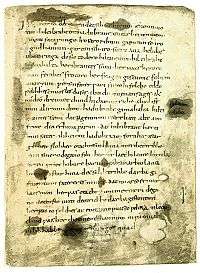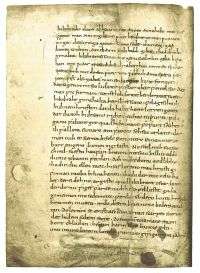Hildebrandslied


The Hildebrandslied (lay or song of Hildebrand) is a heroic epic poem written in Old High German alliterative verse. It is one of the earliest literary works in German, and it tells of the tragic encounter in battle between a son and his unrecognized father. It is the only surviving example in German of a genre which must have been important in the oral literature of the Germanic tribes.
Synopsis
The opening lines of the poem set the scene: two warriors meet on a battlefield, probably as the champions of their two armies.
As the older man, Hildebrand opens by asking the identity and genealogy of his opponent. Hadubrand reveals that he did not know his father but the elders told him his father was Hildebrand, who fled eastwards in the service of Dietrich (Theodoric) to escape the wrath of Otacher (Odoacer), leaving behind a wife and small child. He believes his father to be dead.
Hildebrand responds by saying that Hadubrand will never fight such a close kinsman (an indirect way of asserting his paternity) and offers gold arm-rings he had received as a gift from the Lord of the Huns (the audience would have recognized this as a reference to Attila, whom according to legend Theodoric served).
Hadubrand takes this as a ruse to get him off guard and belligerently refuses the offer, accusing Hildebrand of deception, and perhaps implying cowardice. Hildebrand accepts his fate and sees that he cannot honourably refuse battle: he has no choice but to kill his own son or be killed by him.
They start to fight, and the text concludes with their shields smashed. But the poem breaks off, not revealing the outcome.
The text
The text consists of 68 lines of alliterative verse, though written continuously with no consistent indication of the verse form. It breaks off in mid-line, leaving the poem unfinished at the end of the second page. However, it does not seem likely that much more than a dozen lines are missing.
The poem starts:
Ik gihorta ðat seggen |
I heard tell |
The text is highly problematic, both because of the circumstances of its transmission and because of the uniqueness of the work. Although the written text presents no gaps, a number of places have been identified where the text appears not to follow or there are incomplete lines of verse, suggesting missing text. Other apparent illogicalities suggest misattributed direct speech and lines out of order, though these remain matters of debate.
While it has always been accepted that the text derives ultimately from an oral original, it is unlikely that the surviving text was transcribed directly from oral performance, or indeed written down by someone competent in the oral tradition. The transpositions, apparent lacunae, and unwarranted insertions all indicate a text copied from an earlier manuscript by scribes with only a partial understanding of the poetic form. The mixture of dialects and other linguistic oddities found in the text could also indicate that the poem was intentionally written to appear to be older than it was.
The manuscript
The manuscript of the Hildebrandslied is now in the Murhardsche Bibliothek in Kassel and was discovered around 1715 by Johan Georg von Eckert. It is assumed to derive, like much else in the library's collection, from the monastery of Fulda.
It is written on two leaves of parchment, the first and last in a theological codex. The codex itself was written in the first quarter of the 9th century, with the text of the Hildebrandslied added in the 830s on the two remaining blank leaves. There is no evidence to support the suggestion of a missing third leaf which would have contained the end of the poem.

The manuscript is the work of two scribes, of whom the second wrote only 11 lines at the beginning of the second leaf. The hand is mainly Carolingian minuscule. A number of features, including the wynn-rune used for w suggest Old English influence, not surprising in a house founded by Anglo-Saxon missionaries.
The manuscript pages now show a number of patches of discoloration. These are the results of attempts by earlier scholars to improve the legibility of the text with chemical agents.
At the end of the Second World War the codex went missing, looted by a US army officer and sold into the rare book trade. It was eventually discovered in California and returned to Kassel in 1955. However, the first sheet had been cut out by ignorant antiquarian bookdealers, and it was only in 1972 that this was rediscovered in Philadelphia and returned. Further damage had been done to this leaf in order to help disguise its origin.
The dialect
One of the most puzzling features of the Hildebrandslied is its dialect, which is a mixture of Old Bavarian and Old Saxon. For example, the first person pronoun appears both in the Old Saxon form ik and the Old High German ih. The reason for the dialect mixture is unknown, but it seems certain it cannot have been the work of the last scribes and was already present in the original which they copied.
The Old Saxon features predominate in the opening part of the poem and show a number of errors, which argue against an Old Saxon original. The alliteration of riche and reccheo in line 48 is often regarded as conclusive: the equivalent Old Saxon forms, rīke and wrekkio, do not alliterate and would have given a malformed line. Earlier scholars envisaged an Old Saxon original, but an Old High German original is now universally accepted.
The errors in the Old Saxon features suggest that the scribe responsible for the dialect mixture was not thoroughly familiar with the dialect. Forms such as heittu (l.17) and huitte (l.66) (Modern German heißen and weiß) are mistakes for Old Saxon spellings with a single ⟨t⟩. They suggest an Old High German scribe who does not realise that Old High German zz, resulting from the High German consonant shift, corresponds to t in Old Saxon in these words, not tt.
The origin of the Dietrich legend in Northern Italy also suggests a southern origin is more likely.
The East Franconian dialect of Fulda was High German, but the monastery was a centre of missionary activity to Northern Germany. It is therefore not unreasonable to assume there was some knowledge of Old Saxon there, and perhaps even some Old Saxon speakers. However, the motivation for attempting a translation into Old Saxon remains inscrutable, and attempts to link it with Fulda's missionary activity among the Saxons remain speculative.
An alternative explanation treats the dialect as homogeneous, interpreting it as representative of an archaic poetic idiom.
Analogues and the ending
Although the ending is missing, later works which draw on the same legendary material offer evidence about the original conclusion:
- In the 13th century Old Norse Thiðrekssaga, Hildibrand defeats his son, Alibrand. Alibrand offers his sword in surrender but attempts to strike Hildibrand as he reaches for it. Hildibrand taunts him for having been taught to fight by a woman, but then asks if he is Alibrand and they are reconciled.[1]
- The Early New High German Jüngeres Hildebrandslied (first attested in the fifteenth century) tells a similar story of the treacherous blow, the taunt that the son was taught to fight by a woman, and the final reconciliation.
- In the 14th century Old Norse Ásmundar saga kappabana, Hildebrand's shield bears paintings of the warriors he has killed, which include his own son.
- In the Faroese ballad Snjólvskvæði, Hildebrand is tricked into killing his son.
- In Book VII of the Gesta Danorum (early 13th century), Hildiger reveals as he is dying that he has killed his own son.
Even though some of these versions end in reconciliation, this can be seen as a concession to the courtly tastes of a later period. The heroic ethos of an earlier period would leave Hildebrand no choice but to kill his son after the treacherous stroke, and this is preserved in the other analogues.
Analogues in other Indo-European folklore
There are three main legends in other Indo-European traditions about an old hero who must fight his son and kills him after distrusting his claims of being the father, thus letting us know that probably the Lay ends with Hildebrand killing his son:
- In Irish medieval literature, the hero Cú Chulainn kills his son Conlaí.[2]
- In the Persian epic tale Shahnameh, Rostam kills his son Sohrab.
- In a popular Russian Bylina, Ilya Muromets kills his son Podsokolnik.
The historical background
Although there is no evidence that Hildebrand himself was a historical character, the background to the poem is formed by historical events in the late fifth century, when the Ostrogothic King Theodoric fought for mastery of Italy against Odoacer, the Germanic general who had deposed the last western Roman emperor, Romulus Augustulus, and reigned as King of Italy (476-493). Theodoric appears widely in Germanic legend as Dietrich von Bern (Verona).
Theodoric's Gothic Kingdom of Italy was subsequently seized by the Lombards, who had close connections with the Bavarians in South Germany, both speaking closely related Upper German dialects. This accounts for the transmission of legendary material relating to Theodoric northwards. Even if the Scandinavian analogues did not suggest wider dissemination, the close links between Bavaria and Fulda - the first abbot Sturmi was a member of the Bavarian nobility - would in any case be sufficient to account for knowledge of this material in the monastery.
The Hildebrandslied hints at Theodoric's legendary (and historically incorrect) connection with Attila, which is also seen in the Nibelungenlied.
References
- ↑ Henrik Bertelsen (ed.), Þiðriks saga af Bern, Samfund til udgivelse af gammel nordisk litteratur, 34, 2 vols (Copenhagen: Møller, 1905–11), chs 406-8; Haymes, Edward R. (trans.), The Saga of Thidrek of Bern, Garland Library of Medieval Literature, Series B, 56 (New York: Garland, 1988), pp. 248-50 [chs 406-8].
- ↑ "The Tragic Death of Connla", Celtic Literature Collective
Sources
- Althochdeutches Lesebuch, ed. W.Braune, K.Helm, E.A.Ebbinghaus, 17th edn, Tübingen 1994. ISBN 3-484-10707-3. Provides an edited text of the poem which is widely used and quoted.
- J. Knight Bostock, A Handbook on Old High German Literature, 2nd edn, revised by K.C.King and D.R.McLintock, (Oxford 1976) ISBN 0-19-815392-9. Includes a translation of the Hildebrandslied into English.
- K. Düwel, "Hildebrandslied" in Die deutsche Literatur des Mittelalters. Verfasserlexikon (de Gruyter, 1981), Vol 3. ISBN 3-11-008778-2. With bibliography.
- Cyril Edwards, "Unucky Zeal: The Hildebrandslied and the Muspilli under the Acid" in The Beginnings of German Literature (Camden House, 2002) ISBN 1-57113-235-X
- Wolfram Euler: Das Westgermanische - von der Herausbildung im 3. bis zur Aufgliederung im 7. Jahrhundert - Analyse und Rekonstruktion. 244 p., London/Berlin 2013, ISBN 978-3-9812110-7-8. (Including a Langobardic version of the Lay of Hildebrand, pp. 213–215.)
- Willy Krogmann: Das Hildebrandslied in der langobardischen Urfassung hergestellt. 106 p., Berlin 1959.
- Opritsa D. Popa: Bibliophiles and bibliothieves : the search for the Hildebrandslied and the Willehalm Codex. Berlin 2003. ISBN 3-11-017730-7
External links
- Wikisource Hildebrandslied
- Manuscript and transcription (Bibliotheca Augustana)
- Text with English translation and explanation of individual words
- Reading of the Lay of Hildebrand in Old High German and in its hypothetic Langobardic original version as reconstructed in 2013 by Wolfram Euler, with subtitles in English.
- Summary of Popa's book on the recovery of the MS from the USA